

Against All Odds -
The Story of Millie, The Tiny Twin Alpaca
I've never felt I was any special kind of hero. Millie was the little fighter! Still there are some who shared in her early life who will tell you she lived because of me. (Don't believe 'em!)
When Gary and I first met alpacas we were told, among other things, that an alpaca's gestation is a little over 11 months (give or take a week or two), that they usually give birth by lunchtime, and that live-birth twins are so rate it is almost safe to say that twins just don't happen. Well, I'm here to say that alpacas didn't read the book! Each year I've been in the business I hear of more sets of twins born that survive to adulthood; though none were as teeny-tiny as Millie and Jackie each were.
It all began when I found Millie's tiny hypothermic body lying on its side, limp and gasping for breath in the shade that cold late November afternoon.
Even though I'd been through many First Aid and EMT classes and had helped to whelp numerous litters of puppies, as our first two girls approached their "due" dates, I read and reread as much as I could find on handling of dystocias and neonatal care. No matter how often I was told that raising alpacas wasn't rocket science, I didn't believe it. After all, alpacas aren't dog and they certainly aren't people!
Then, just as we had been assured would happen, our first two crias arrived without difficulty, between 9 and 10 am, after 11 1/2 months of gestation. The girls were rebred easily, settling about 10 days apart, and the waiting game began again.
By the end of her second trimester Asti was beginning to look big. Really big! When friends teased that she looked like she was having twins, we reminded them sweetly that twins were extremely rare and that she had gotten pretty big in her previous pregnancy, too. Well, maybe not this big, but, her, twins almost never happen so why even think it!
On the evening of November 1st, Peanut was showing signs of possible labor. She was eating and chewing her cud, but was noticeably uncomfortable just the same. We agreed we needed to keep a closer eye on her and sure en ough at 9 am on the 2nd she delivered a lovely grey girl. Meanwhile, Asti was still getting bigger and bigger, but at 357 days she was still showing no signs of delivery any time soon.
Gary and I had a 2 o/clock appointment in town so we checked on everyone as usual before we left. Peanut and her cria were fine and bonding in their paddock area. Our yearling male was contentedly sunning himself in his paddock area. And Asti was happily grazing with the yearling female in another paddock area. All was right in their world so off we went to our appointment.
When we got home shortly after 4, Gary went out to start evening chores while I made a quick business call. Suddenly Gary ran back in to say he though I needed to come quickly, that Asti had something hanging from her and he thought she might be having her cria. Having been told that alpacas usually only deliver in the morning I knew something must be wrong and quickly called our mentors, Bruce and Jeri Beatty. Before I was off the phone with Bruce, Gary ran back in to say he thought she might have had twins. I screamed something about "TWINS!" into the phone and hung up. Fortunately, the Beattys only live 3 or 4 miles down the road; but still they were at our farm in record time.
Meanwhile, I had run out to the back pasture where I
found a tiny white cria lying on its side in the dark shade, soaking wet, and
gasping for breath. The poor thing was turning blue with cold. I
grabbed it up and stuffed it inside my shirt for warmth as I tried to also dry
it off. In the sun, not far away, was a tiny fawn cria, cushed and
looking
around. Oh my gosh! We had actually just had twins! And they
both were girls!
The sun was setting behind the mesas and the temperature was dropping rapidly when Bruce and Jeri arrived. We took a quick assessment of things and the four of jus -- Gary, Bruce, Jeri, and I -- went to work. Towels! Karo syrup! Iodine! Hair dryer! More towels! Try to get someof mama's colostrum into them! Off to the scale to weigh them! Dry them some more!
The little fawn girl weighed 6 1/2 pounds. Typical
birth weight for a baby alpaca is usually over 15 pounds,
but she was up and
nursing as best she could for something so tiny. But all-a-all, she was
doing very well.
The little white girl, on the other hand, was only 4 1/2 pounds. She had an ulcerated eye and one leg was so greatly deformed it would not allow her to stand. And even if she could have stood, she was too tiny to reach her mama's teats. So, as I cuddled this tiny white cria in the dark of night, Bruce and Gary held Asti so Jeri could "milk" her. We so hoped we could get even a little colostrum into her tiny body.
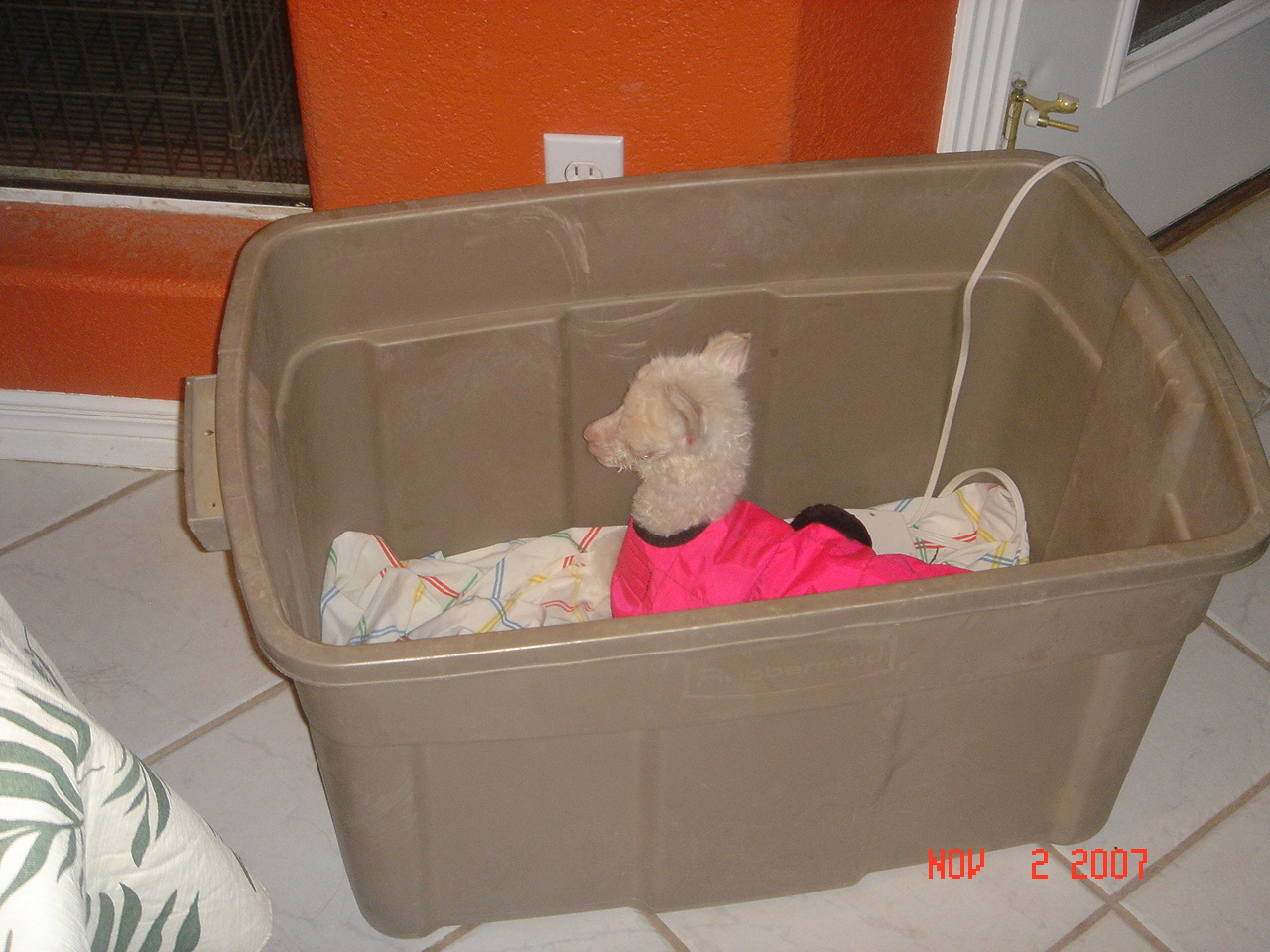 Gary fixed a little bed for her with a heating pad in a
Rubbermaid tote in an area of our kitchen where it adjoins the TV room. We slept
in our respective recliners in front of the television that night, taking turns
trying to get her to take tiny amounts of cows' milk from a 3mL syringe.
She had no suck reflex but would swallow a little at a time. Was this baby
going to live? I wasn't sure I was doing her any favors.
Gary fixed a little bed for her with a heating pad in a
Rubbermaid tote in an area of our kitchen where it adjoins the TV room. We slept
in our respective recliners in front of the television that night, taking turns
trying to get her to take tiny amounts of cows' milk from a 3mL syringe.
She had no suck reflex but would swallow a little at a time. Was this baby
going to live? I wasn't sure I was doing her any favors.
The next day is a blur. Thanks goodness it was the
weekend! Visitors came and went.
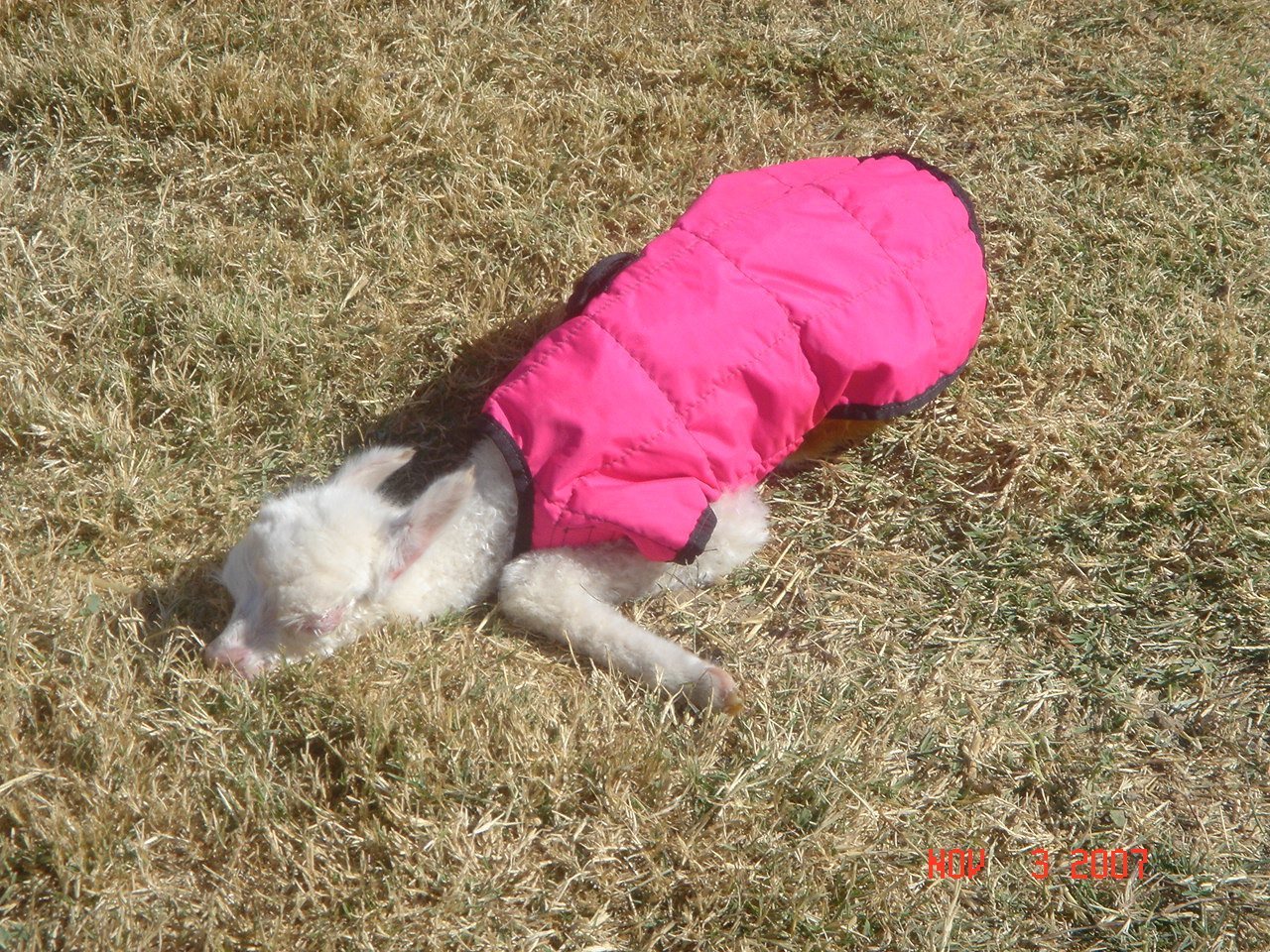 Bruce came to help us draw blood
for IgG's. He was on the phone with various people about plasma
administration and lack of urine output in the little white twin. At the
suggestion of Steve Hull, we adjusted her
formula a little,
adding some Half-n-Half to the whole cows' milk. All three of the crias
born the previous day were orally given a share of the bag of plasma I had
stored in the freezer. I think the only thing enamored with the plasma was
a Yellow Jacket that buzzed around us for a while and eventually stung me.
Bruce came to help us draw blood
for IgG's. He was on the phone with various people about plasma
administration and lack of urine output in the little white twin. At the
suggestion of Steve Hull, we adjusted her
formula a little,
adding some Half-n-Half to the whole cows' milk. All three of the crias
born the previous day were orally given a share of the bag of plasma I had
stored in the freezer. I think the only thing enamored with the plasma was
a Yellow Jacket that buzzed around us for a while and eventually stung me.
At less than 24 hours old, the white twin was give the name Millie (short for Milagro) by a friend. She was, indeed, a miracle! Slowly Millie become strong enough to walk a bit on her own, but still needed help in getting up.
Millie's so very tiny compared to the grey girl born about seven hours earlier!
By Monday, the ulcer in Millie's eye wasn't looking any better so I put her into the car's Pet-Porter crate for a trip to see my small animal vet. She, of course, was a hit in the waiting room where most people had never heard of an alpaca let alone seem one.
Poor Millie had two bad ulcerations in her eye that would need ot be treated with a multi-antibiotic ointment several times a day. Most people would have been horrified if they'd seen me put her up on the island counter in my kitchen when I needed to put the ointment in her eyes. However, as people warned me not to make too much of a pet of her, I couldn't help but wonder how long it would be before Millie associated mypresence with something terrible about to happen to her.
But the ulcers in her eye healed with her learning to
dread me. And as time went by I learned to hum in encouragement at the
bean pile, especially on cold windy nights. As she grew older she learned
this was a good time to stir ip "trouble" among the rest of the herd and would
take off pronking to visit the other crias. You could tell by the looks on
their mamas' faces that they were none too pleased.
In the early days I often sat in a white plastic chair to feed Millie and she began to go to the chair when she was hungry or for security. As you can see, her back is lower than the seat of the chair. That cria cost she's wearing is an extra-small, 14 inches in length. Millie was very tiny!
As the days went by, however, this chair almost became Millie's demise. She went to the chair for comfort and companionship. When the weather turned foul one day, Millie lay down next to the white plastic chair rather than going with the rest of the herd into the barn. I moved the chair into the barn.
I should have recognized that something was wrong when Millie's eating slowed down dramatically. I had figured she was filling up on the weeds she'd been nibbling on. Little did I know she was filling her tummy with air as she tried to suckle the white plastic chair. As I said earlier, she seemed to be living in spite of all the mistakes I was making. If I hadn't gone out that one day to give the crias their vitamin gel she might have slowly starved to death.
Almost immediately after I had given them their vitamins, Millie started coughing and gasping for breath. I knew she wasn't truly choking -- at least I couldn't imagine why she would be. I'd put the gel on my finger and then against the roof of her mouth; certainly not down her throat. But as I watched she quite literally started going into shock. Millie had fought my putting "that stuff" in her mouth and then she started to crash.
As usualy I was home alone so (again "as usual") I called Bruce Beatty who arrived within moments with a cell phone to his ear, talking to Steve Hull. We did a quick check of Millie's blood glucose and found it to be really low. So on Steve's instructions we started her on Karo syrup, 5mL at a time. She sputtered the Karo out and I had a devil of a time getting into her the amount Steve recommended in the time period he recommended and then whoops! her blood sugar was too high! But we got it straightened out and Millie and I dodged a big bullet that day. Though just one of several.
Because Millie was so very tiny, she was gaining weight at only fractions of an ounce each day rather than fractions of a pound. My livestock scale registered in pound and half-pound increments only, so I had to find a way to have the scale recalibrated or, heavens above, buy another scale. I didn't want to send it back to the manufacturer; that would cost dearly in time and money.
Since Millie was on a two-hour feeding schedule, I knew I couldn't be away from home much longer than that. But some days I just live right! I was able to find a company about a half hour away and the nice man there eventually found he was able to recalibrate the scale such that it would weight in 2-ounce increments. That would have to do; he couldn't change it any lower than that. At least I could be a bit more accurate when I weighed her. I was home again in just under three hours!
Then one morning I found Millie with her head hanging, weak in the legs, and apparent abdominal pain. Her temp, pulse, and respiration were borderline low. Nothing terribly remarkable but obviously something was very wrong. And Millie didn't want to eat. I dribbled milk into her mouth with some Karo and she rallied a bit. We had some cold rain that day so she spent that day and the next inside. When she was finally able to go outside again she showed her joy running and pronking. We never knew what was wrong.
My Steve-Hull-approved bottle formula was working well. Millie continued to thrive and we celebrated when she finally reached 10 pounds. That was really a pretty big deal for someone who was only gaining about an ounce a day.
Then no sooner had Millie reached 10 pounds than suddenly one night at bedtime she had diarrhea . . . as in liquid discharge running down her legs every time she moved. I treated her with an anti-diaarrheal and spent the night sleeping in the recliner. Every time she made a sound i was up to check on her. I carried her to and from her pen in the kitchen to the bean pile in the paddock outside the back door. The next morning she still had diarrhea. I gave her some MSE paste in applesauce. One again I had to dribble milk into her mouth because she wouldn't drink. But two hours later she more willingly took a little milk. Her urine output was almost nil, thogh the diarrhea seemed a little better. I gave her more MSE in applesauce. Three hours later she drank a normal -- for Millie -- amount of milk. I think this scared me more than almost anything so far.
I kept endless records of everything Millie did and when, as well as the amount of milk she drank/when and any-and-everything that happened in her little life. My sons' baby books aren't as detailed! But I can go back now and help anybody else dealing with a similar situation. Heaven forbid I might have to do it again myself!
As Christmas approached, Millie was drinking water like a adult alpaca, nibbling on alfalfa leaves, and picking at the pellet supplement for mamas and crias. I don't remember anything about the holidays that year; Millie was thriving and that was all that mattered. I bought a large commercial Shop Vac because Millie was now making quite a mess in my kitchen and my normal house vacuum couldn't handle the alfalfa.
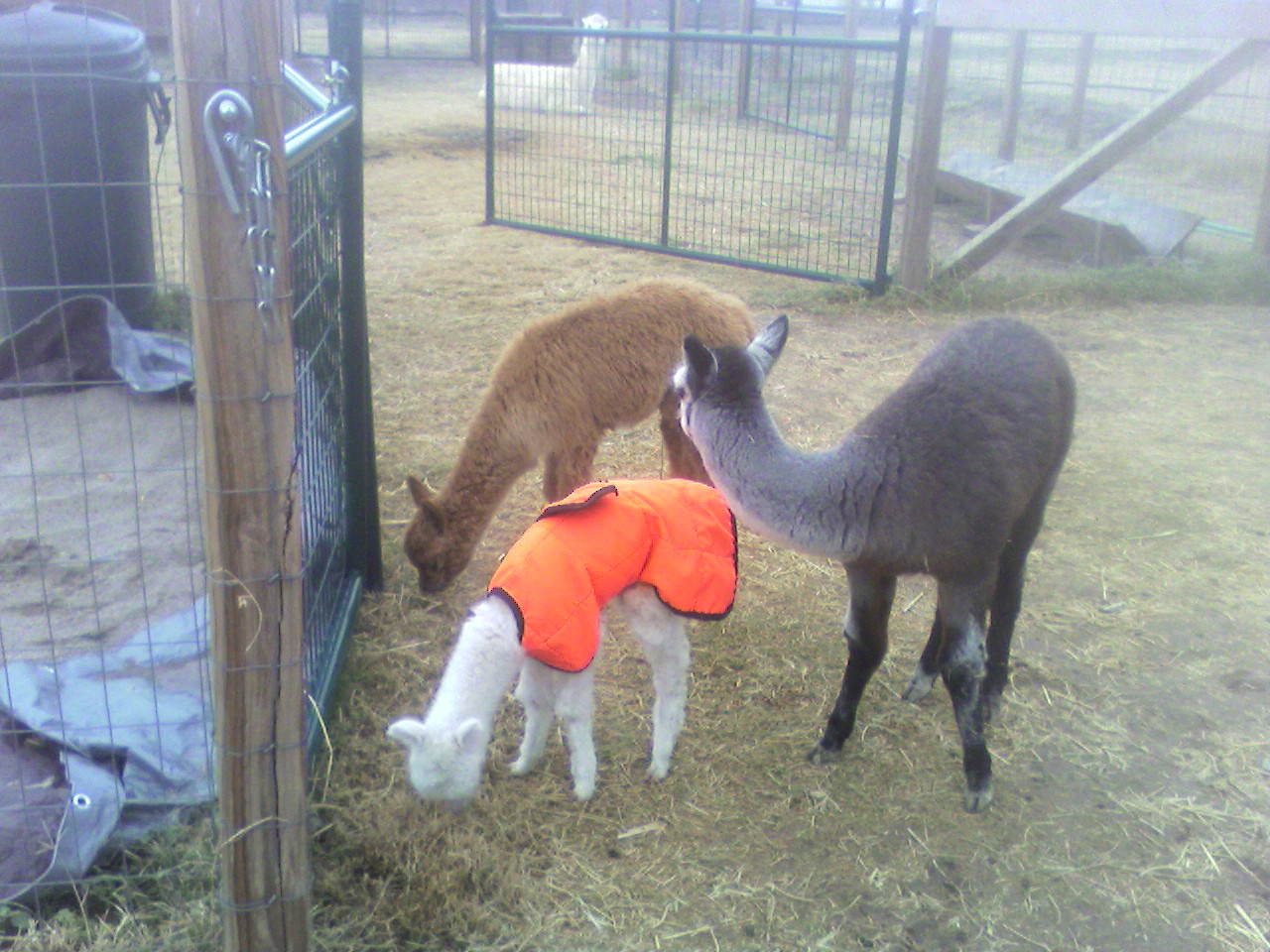
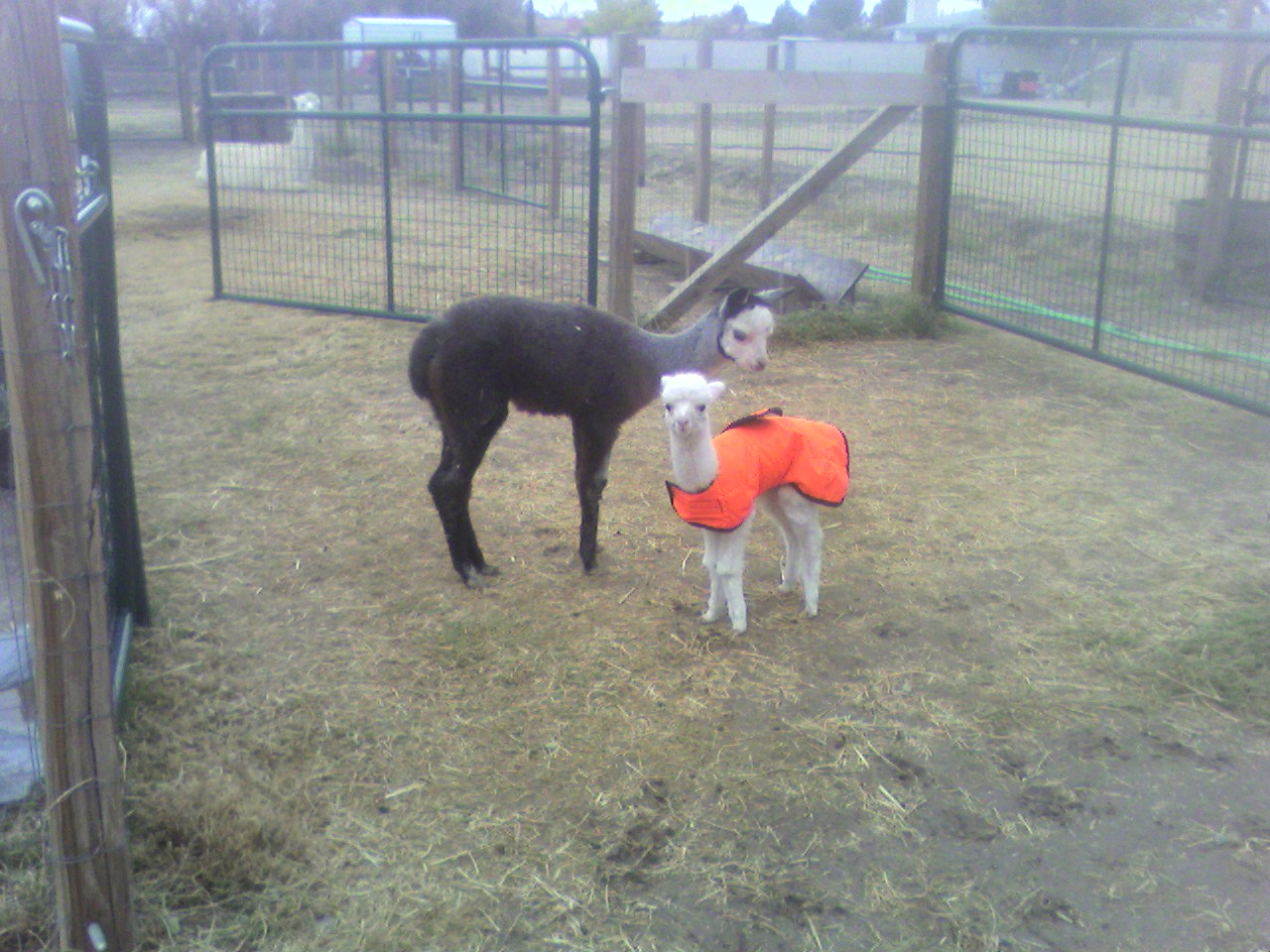
As much as Millie was growing it was obvious she was never going to totally catch up to her twin sister and especially to the grey girl born the same morning.
Still as time went on Millie slowly weaned herself from the milk formula and ate more forage and hay. She would come in twice a day for some alfalfa but would spend most of the day and all night outside with the rest of the herd. All was going along smoothly. She slept in her self-appointed little corner of the pasture and each morning wouldpop up and run to the gate when I let the dogs out.
Then one morning early in June Millie didn't pop up and come to the gate. I didn't think much about it at first . . . until I realized about an hour later that she was still lying in the same place and holding her head in a very strange position. I went out to check on her and found her with thick milky mucous clogging one nostril. I scooped her up and ran with her back to the house in tears. Millie and I had come way too far for something to kill her now! She had a temp of 104.3º F so I started her on antibiotics immediately. Within 12 hours her previously lethargic attitude was improving and the discharge was beginning to clear. She was eating and drinking again; her uring output and beans were normal. The next morning I found her in her usual spot bright and alert. Two weeks later I found her with more thick milky nasal discharge. This time I call Dr. McCaslin who assured me that Millie didn't have :the snots" (a respiratory problem that seemed to be going around the show circuit) which would be a yellow-green discharge from both sides. What Millie had was indicative of an allergic reaction tosomething. That made sense sine the earlier time her nose had appeared swollen on the one side. so maybe a bee sting? or ant bite?
.jpg) Because she was raised with our seven Australian
Shepherds, Milie has no fear of the dogs. She shoves her way through the
pack to get in the back door and often will check out whatever it is that one
might happen to be chewing on. It's good they have wonderful dispositions;
she doesn't know she could easily be a snack. In her mind -- and theirs --
she's the boss!
Because she was raised with our seven Australian
Shepherds, Milie has no fear of the dogs. She shoves her way through the
pack to get in the back door and often will check out whatever it is that one
might happen to be chewing on. It's good they have wonderful dispositions;
she doesn't know she could easily be a snack. In her mind -- and theirs --
she's the boss!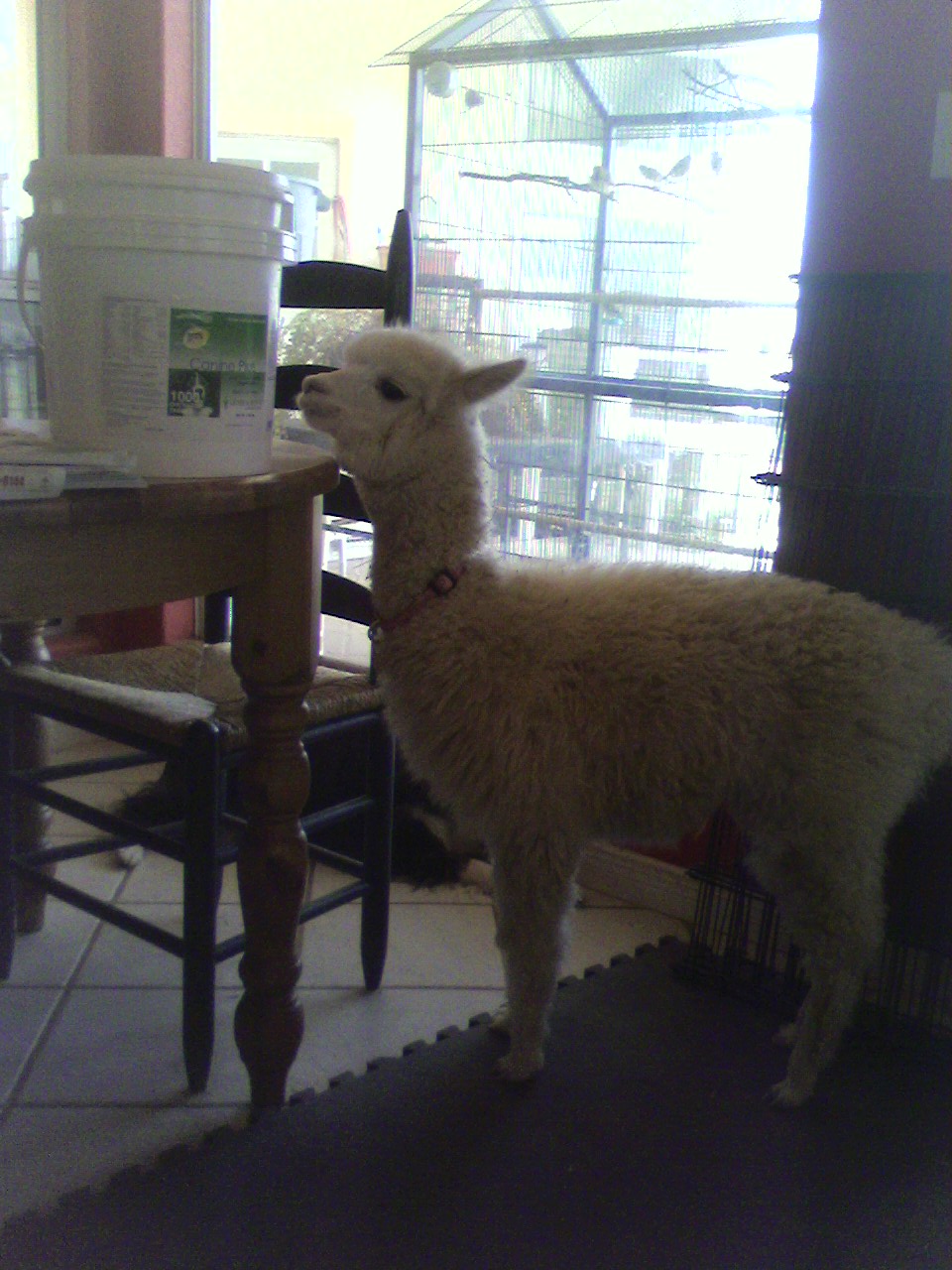
Millie totally enjoys coming inside to checkout what she's been missing, to remove papers from your desk or carry off magazines from the coffee table. But most of all she enjoys watching television, from football games to The Godfather.
Millie has now pretty much adjusted to being an alpaca, though she is very independent and definitely has a mind of her own, often behaving like a spoiled only child. She doesn't seem to realize that humans aren't also alpacas and will just as willingly spit at one of us as at another alpaca, especially when she doesn't get her way. However, she also gives lots of kisses, especially to young visitors. But because of her size she is still picked on by many of the other alpacas, though she often holds her own.
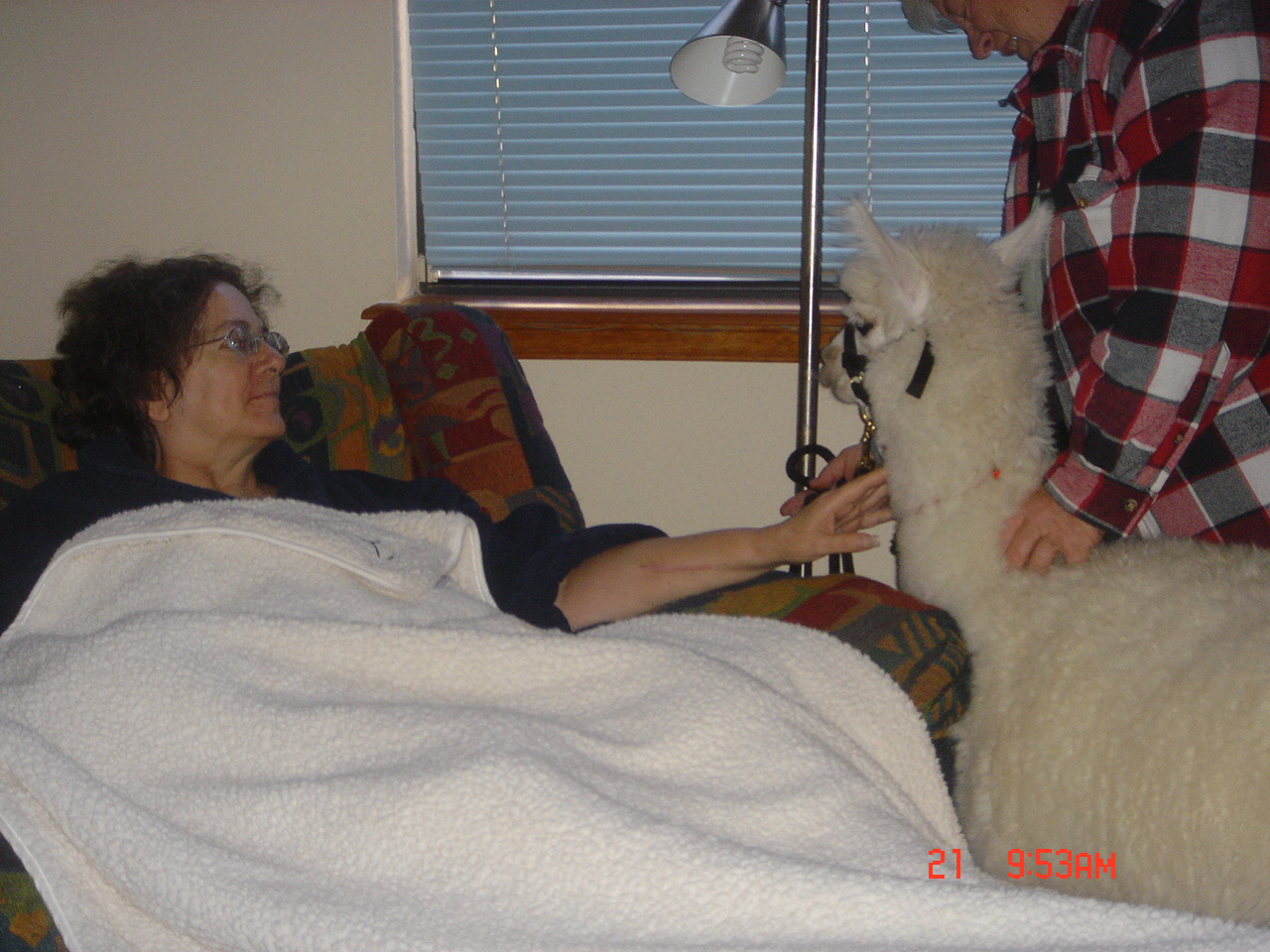
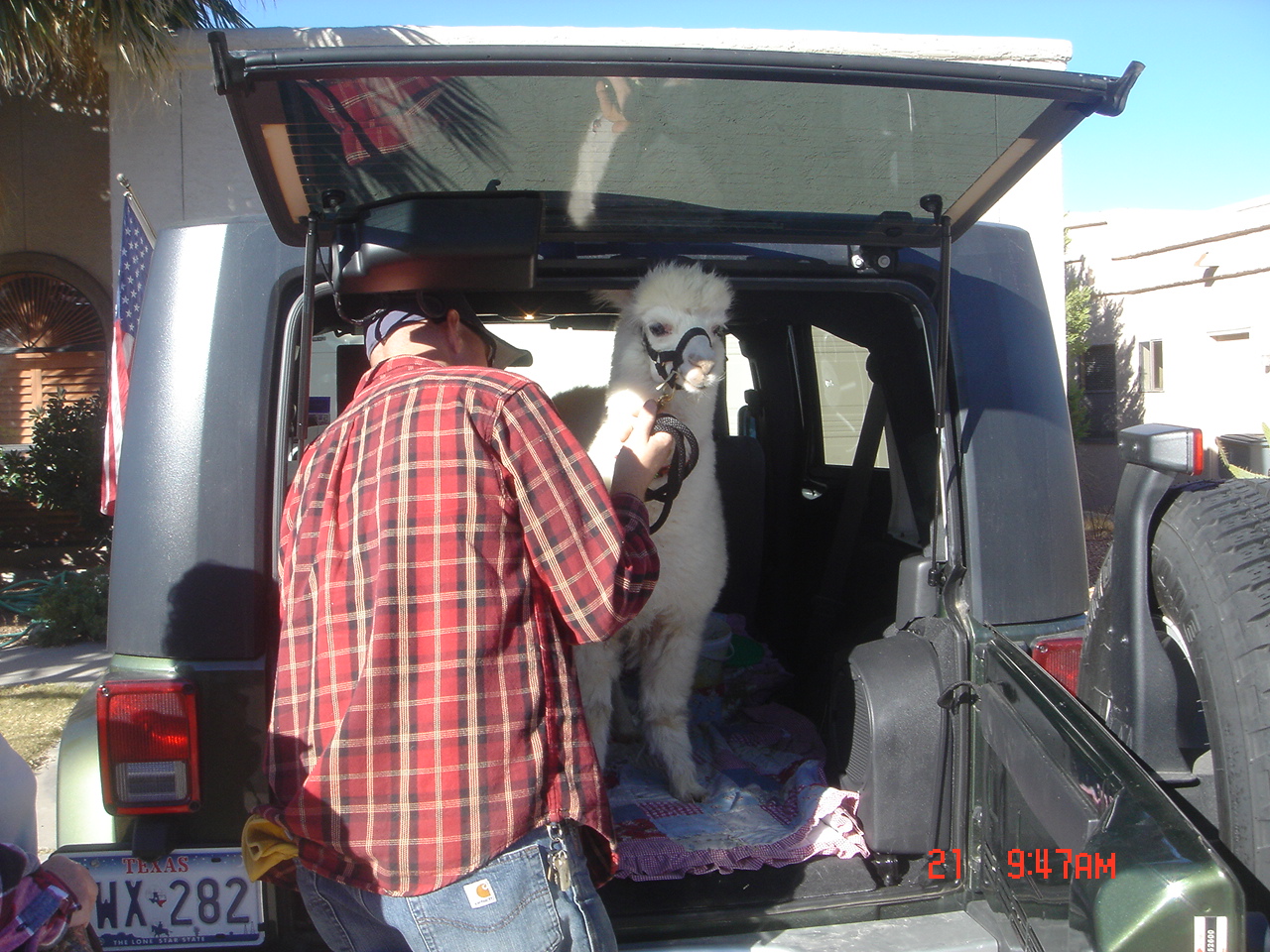 Late in 2008, a friend of ours, knowing her time of
passing was near, told her immediate family there were a few things she still
wanted to do. Even though our friend had been to visit our farm numerous
times she had never seemed to want to be closer to the animals than about six
feet from the outside fence. However, one of her wishes was to pet an
alpaca. So a little more than a month before our friend passed, Millie was
loaded into the back of my Jeep and went to visit our friend who was no longer
able to leave her home. What an angel Millie was! She patiently stood at
our friend's chair-side for about 45 minutes as our friend stroked her and
stroked her. Eventually Millie cushed in the same location and stretched
her neck so our friend could still reach her head. However, it wasn't
until our friend's funeral that I personally learned that petting an alpaca had
been one of her dying wishes. Precious Millie had made that wish come
true!
Late in 2008, a friend of ours, knowing her time of
passing was near, told her immediate family there were a few things she still
wanted to do. Even though our friend had been to visit our farm numerous
times she had never seemed to want to be closer to the animals than about six
feet from the outside fence. However, one of her wishes was to pet an
alpaca. So a little more than a month before our friend passed, Millie was
loaded into the back of my Jeep and went to visit our friend who was no longer
able to leave her home. What an angel Millie was! She patiently stood at
our friend's chair-side for about 45 minutes as our friend stroked her and
stroked her. Eventually Millie cushed in the same location and stretched
her neck so our friend could still reach her head. However, it wasn't
until our friend's funeral that I personally learned that petting an alpaca had
been one of her dying wishes. Precious Millie had made that wish come
true!
At barely have the size of a normal female alpaca, Millie will probably never be bred. She will always be our public relations representative and therapy alpaca . . . and a constant source of amusement and pure joy.
From the beginning Millie has been a fighter for survival.
Without a doubt it was the fight in both of us that allowed her to share 3 1/2 years with us.
Sadly, we will never know what caused the fluid to fill her tiny lungs and take her so quickly from us. RIP my "Mini-Mill"!
2 November 2007 - 22 June 2011
This page is dedicated to my late mother whose final words to me were to go pet Millie for her.
_____________________________________________________________________________________________________________________________________________________________________________________________________________
© 2005-2014. Driwind Farms. All Rights Reserved. Home